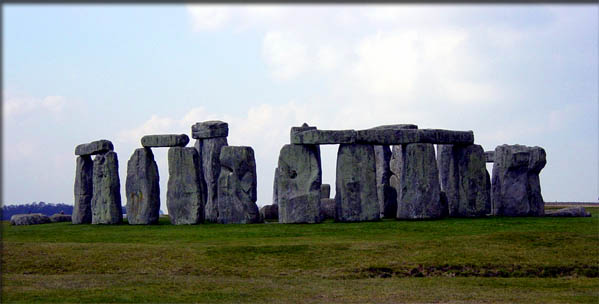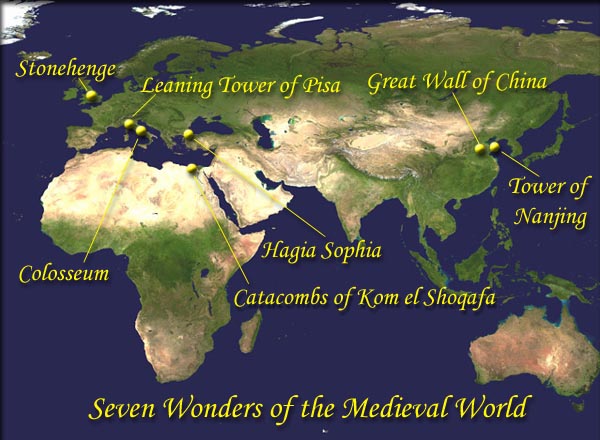The
Seven Wonders of the Medieval World

Stonehenge
- Stonehenge, in many peoples' minds, is the most mysterious
place in the world. This set of stones laid out in concentric
rings and horseshoe shapes on the empty Salisbury Plain, is,
at the age of 4,000 years, one of the oldest, and certainly
best preserved, megalithic (ancient stone) structures on Earth,
but we know almost nothing about who built Stonehenge and why.
The
Leaning Tower of Pisa: Flawed Beauty - In 1990 an international
team of engineers, mathematicians, and historians met on the
Azores Islands in the middle of the Atlantic Ocean. Their task
was to figure out how to save an 800-year-old historic building
that was close to collapsing. The structure was then tilted
by 5.5 degrees to one side. If something wasn't done soon, the
world famous Leaning Tower of Pisa would come crashing to the
ground.
Coliseum:
The Great Arena - The Flavian Amphitheater, as it was
then known would become the largest public entertainment venue
in the Roman Empire and eventually a symbol of the city of Rome
itself. For 18 centuries it remained the largest amphitheater
in the world. Today we call this zenith of Roman architecture
and engineering the Coliseum.
Hagia
Sophia: The Place of Holy Wisdom - Before it became
a famed Islamic Mosque this wonder of the medieval world was
the largest cathedral on the planet for almost a thousand years.
The
Great Wall - In China there is something that for hundreds
of years has let its long, snake-like form lay across the Asian
countryside defending it from outsiders. Many writers have likened
this thing to a dragon. Most people, however, call it the Great
Wall of China.
The
Catacombs of Kom el Shoqafa - Tradition has it that
on Friday, September 28th, 1900, in Alexandria, Egypt, a donkey,
hauling a cart full of stone, made a misstep and disappeared
into a hole in the ground. If that story is accurate, this beast
of burden made one of the most astounding discoveries in archeological
history: A set of rock-cut tombs with features unlike that of
any other catacomb in the ancient world.
The
Lost Porcelain Pagoda - "The best contrived and noblest
structure of all the East," said theFrench mathematician, Le
Comte, when he saw it. This 19th century visitor to China was
referring to the astonishing Tower of Najing, a wondrous temple
that today is gone.

Sometime
in the late 19th or early 20th century a list entitled The
Seven Wonders of the Medieval World started to be found
among the various catalogs of marvels. It has alternately also
been entitled the Wonders of the Middle Ages, the Seven Wonders
of the Middle Ages, the Seven Wonders of the Medieval Mind,
and the Architectural Wonders of the Middle Ages. The
list includes Stonehenge, the Coliseum, the Catacombs of Kom
el Shoqafa, the Great Wall of China, the Porcelain Tower of
Nanjing, Hagia Sophia and Leaning Tower of Pisa. The list does
not actually seem to date back into the middle ages t times
as the titles, including the words Medieval and the term
Middle Ages, did not become popular until the Enlightenment
around the 17th century. Moreover, the Catacombs of Kom el Shoqafa
were not discovered until, the beginning of the 20th century.
It
is possible, however, that other wonders may have occupied earlier
versions of the list. Some of the alternate candidates include
the Taj Mahal, the Cairo Citadel, the Ely Cathedral and Cluny
Abbey
